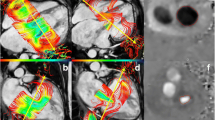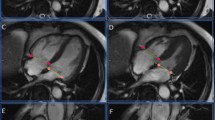Abstract
To determine the optimal plane of two-dimensional velocity-encoding cine (VENC) magnetic resonance (MR) imaging at the tricuspid annulus for quantification of tricuspid regurgitation (TR) and to assess the reproducibility of VENC tricuspid flow measurements. We conducted a retrospective review of MR images of 25 consecutive patients (M:F = 8:17; mean age, 58.5 ± 10.5 years) with TR. VENC was performed twice orthogonal to the tricuspid annulus plane during the end-diastolic (ED) and end-systolic (ES) phases. The TR fraction was quantified at each plane as retrograde flow/antegrade flow and additionally as retrograde flow of the ED plane/antegrade flow of the ES plane (combined plane method). The conventional method to determine the TR amount [right ventricular stroke volume (RVSV)—pulmonary antegrade flow] and TR fraction (TR amount/RVSV) was used as the reference standard. There were no differences between TR amount and retrograde flow of the ED plane (65.3 ± 43.4 vs. 70.5 ± 36.1 ml, P = 0.361) between the RVSV and the antegrade flow of the ES phase (124.2 ± 46.1 vs. 128.0 ± 45.0 ml, P = 0.612) or in TR fraction between the conventional and combined plane methods (48.8 ± 19.2 vs. 56.3 ± 24.3 %, P = 0.08). The retrograde flow of the ED phase was best correlated with TR amount [intraclass correlation coefficient (ICC) = 0.859] and antegrade flow of ES with RVSV (ICC = 0.808). The TR fraction of the combined plane method was best correlated with the conventional method (ICC = 0.694). Interobserver agreement of VENC flow measurements was excellent (ICC, 0.939–0.993). The optimal method for quantification of TR using tricuspid annular VENC was the combined plane method, which divides the retrograde flow of the ED plane by the antegrade flow of the ES plane. Tricuspid flow measurements using VENC showed excellent reproducibility.



Similar content being viewed by others
Abbreviations
- 2D:
-
Two-dimensional
- CI:
-
Confidence interval
- ECG:
-
Electrocardiogram
- ED:
-
End-diastolic
- EDV:
-
End-diastolic volume
- EF:
-
Ejection fraction
- ES:
-
End-systolic
- ESV:
-
End-systolic volume
- ICC:
-
Intraclass correlation coefficient
- LPA:
-
Left pulmonary artery
- MR:
-
Magnetic resonance
- RPA:
-
Right pulmonary artery
- RV:
-
Right ventricular
- RVSV:
-
Right ventricular stoke volume
- SV:
-
Stroke volume
- TR:
-
Tricuspid regurgitation
- TrueFISP:
-
True fast imaging with steady-state precession imaging
- VENC:
-
Velocity-encoding cine
References
Didier D, Ratib O, Lerch R, Friedli B (2000) Detection and quantification of valvular heart disease with dynamic cardiac MR imaging. Radiographics 20(5):1279–1299 (discussion 1299–1301)
Zoghbi WA, Enriquez-Sarano M, Foster E, Grayburn PA, Kraft CD, Levine RA, Nihoyannopoulos P, Otto CM, Quinones MA, Rakowski H, Stewart WJ, Waggoner A, Weissman NJ (2003) Recommendations for evaluation of the severity of native valvular regurgitation with two-dimensional and Doppler echocardiography. J Am Soc Echocardiogr 16(7):777–802
Hannoush H, Fawzy ME, Stefadouros M, Moursi M, Chaudhary MA, Dunn B (2004) Regression of significant tricuspid regurgitation after mitral balloon valvotomy for severe mitral stenosis. Am Heart J 148(5):865–870
McGrath LB, Gonzalez-Lavin L, Bailey BM, Grunkemeier GL, Fernandez J, Laub GW (1990) Tricuspid valve operations in 530 patients. Twenty-five-year assessment of early and late phase events. J Thorac Cardiovasc Surg 99(1):124–133
Porter A, Shapira Y, Wurzel M, Sulkes J, Vaturi M, Adler Y, Sahar G, Sagie A (1999) Tricuspid regurgitation late after mitral valve replacement: clinical and echocardiographic evaluation. J Heart Valve Dis 8(1):57–62
Koelling TM, Aaronson KD, Cody RJ, Bach DS, Armstrong WF (2002) Prognostic significance of mitral regurgitation and tricuspid regurgitation in patients with left ventricular systolic dysfunction. Am Heart J 144(3):524–529
Kwak JJ, Kim YJ, Kim MK, Kim HK, Park JS, Kim KH, Kim KB, Ahn H, Sohn DW, Oh BH, Park YB (2008) Development of tricuspid regurgitation late after left-sided valve surgery: a single-center experience with long-term echocardiographic examinations. Am Heart J 155(4):732–737
Westenberg JJ, Roes SD, Ajmone Marsan N, Binnendijk NM, Doornbos J, Bax JJ, Reiber JH, de Roos A, van der Geest RJ (2008) Mitral valve and tricuspid valve blood flow: accurate quantification with 3D velocity-encoded MR imaging with retrospective valve tracking. Radiology 249(3):792–800
Rebergen SA, Helbing WA, van der Wall EE, Maliepaard C, Chin JG, de Roos A (1995) MR velocity mapping of tricuspid flow in healthy children and in patients who have undergone Mustard or Senning repair. Radiology 194(2):505–512
Rushmer RF, Crystal DK, Wagner C (1953) The functional anatomy of ventricular contraction. Circ Res 1(2):162–170
Meluzin J, Spinarova L, Bakala J, Toman J, Krejci J, Hude P, Kara T, Soucek M (2001) Pulsed Doppler tissue imaging of the velocity of tricuspid annular systolic motion; a new, rapid, and non-invasive method of evaluating right ventricular systolic function. Eur Heart J 22(4):340–348
Kim HK, Kim YJ, Park EA, Bae JS, Lee W, Kim KH, Kim KB, Sohn DW, Ahn H, Park JH, Park YB (2010) Assessment of haemodynamic effects of surgical correction for severe functional tricuspid regurgitation: cardiac magnetic resonance imaging study. Eur Heart J 31(12):1520–1528
Anavekar NS, Gerson D, Skali H, Kwong RY, Yucel EK, Solomon SD (2007) Two-dimensional assessment of right ventricular function: an echocardiographic-MRI correlative study. Echocardiography 24(5):452–456
Bland JM, Altman DG (1986) Statistical methods for assessing agreement between two methods of clinical measurement. Lancet 1(8476):307–310
Carr-White GS, Kon M, Koh TW, Glennan S, Ferdinand FD, De Souza AC, Pepper JR, Pennell DJ, Gibson DG, Yacoub MH (1999) Right ventricular function after pulmonary autograft replacement of the aortic valve. Circulation 100(19 Suppl):II36–II41
Nishimura T, Yamada N, Itoh A, Miyatake K (1989) Cine MR imaging in mitral regurgitation: comparison with color Doppler flow imaging. AJR Am J Roentgenol 153(4):721–724
Wagner S, Auffermann W, Buser P, Lim TH, Kircher B, Pflugfelder P, Higgins CB (1989) Diagnostic accuracy and estimation of the severity of valvular regurgitation from the signal void on cine magnetic resonance images. Am Heart J 118(4):760–767
Duerinckx AJ, Higgins CB (1994) Valvular heart disease. Radiol Clin North Am 32(3):613–630
Simpson IA, Sahn DJ (1991) Quantification of valvular regurgitation by Doppler echocardiography. Circulation 84(3 Suppl):I188–I192
Nayler GL, Firmin DN, Longmore DB (1986) Blood flow imaging by cine magnetic resonance. J Comput Assist Tomogr 10(5):715–722
Mostbeck GH, Caputo GR, Higgins CB (1992) MR measurement of blood flow in the cardiovascular system. AJR Am J Roentgenol 159(3):453–461
Fehske W, Omran H, Manz M, Kohler J, Hagendorff A, Luderitz B (1994) Color-coded Doppler imaging of the vena contracta as a basis for quantification of pure mitral regurgitation. Am J Cardiol 73(4):268–274
Grayburn PA, Fehske W, Omran H, Brickner ME, Luderitz B (1994) Multiplane transesophageal echocardiographic assessment of mitral regurgitation by Doppler color flow mapping of the vena contracta. Am J Cardiol 74(9):912–917
Song JM, Jang MK, Choi YS, Kim YJ, Min SY, Kim DH, Kang DH, Song JK (2011) The vena contracta in functional tricuspid regurgitation: a real-time three-dimensional color Doppler echocardiography study. J Am Soc Echocardiogr 24(6):663–670
Author information
Authors and Affiliations
Corresponding author
Ethics declarations
Conflict of interest
The authors declare that they have no conflict of interest.
Ethical approval
All procedures performed in studies involving human participants were in accordance with the ethical standards of the institutional and/or national research committee and with the 1964 Helsinki declaration and its later amendments or comparable ethical standards. For this type of study formal consent is not required.
Informed consent
Informed consent was obtained from all individual participants included in the study. Our institutional review board approved this retrospective study design and waived the requirement for informed consent.
Electronic supplementary material
Below is the link to the electronic supplementary material.
10554_2015_715_MOESM1_ESM.avi
Supplementary material 1 Movie 1 Velocity map of velocity-encoding cine obtained orthogonal to the tricuspid annulus at the moment of end diastole. Regurgitant tricuspid flow, shown as a black signal, is well visualized during systole (AVI 4053 kb)
10554_2015_715_MOESM2_ESM.avi
Supplementary material 2 Movie 2 Velocity map of velocity-encoding cine obtained orthogonal to the tricuspid annulus at the moment of end systole. Tricuspid inflow, which is shown as a white signal, is well visualized during diastole (AVI 4053 kb)
Supplementary material 3 Movie 3 Demonstration of tricuspid transannular motion during the cardiac cycle on a short-axis cine image orthogonal to the tricuspid annulus during the moment of the end-diastolic phase (AVI 678 kb)
Supplementary material 4 Movie 4 Demonstration of tricuspid transannular motion during the cardiac cycle on a short-axis cine image orthogonal to the tricuspid annulus during the moment of the end-systolic phase (AVI 663 kb)
Supplementary material 5 Movie 5 Demonstration of tricuspid transannular motion during the cardiac cycle on a four-chamber cine image. The yellow line represents the tricuspid annular end-diastolic plane, and the red line indicates the tricuspid annular end-systolic plane (AVI 718 kb)
Supplementary material 6 Movie 6 Demonstration of tricuspid transannular motion during the cardiac cycle on a right ventricular two-chamber cine image. The yellow line indicates the tricuspid annular end-diastolic plane, and the red line represents the tricuspid annular end-systolic plane (AVI 666 kb)
Rights and permissions
About this article
Cite this article
Jun, H., Park, EA., Bahn, Y.E. et al. Quantification of tricuspid regurgitation using two-dimensional velocity encoding cine: optimal plane and reproducibility. Int J Cardiovasc Imaging 31 (Suppl 2), 233–240 (2015). https://doi.org/10.1007/s10554-015-0715-x
Received:
Accepted:
Published:
Issue Date:
DOI: https://doi.org/10.1007/s10554-015-0715-x




